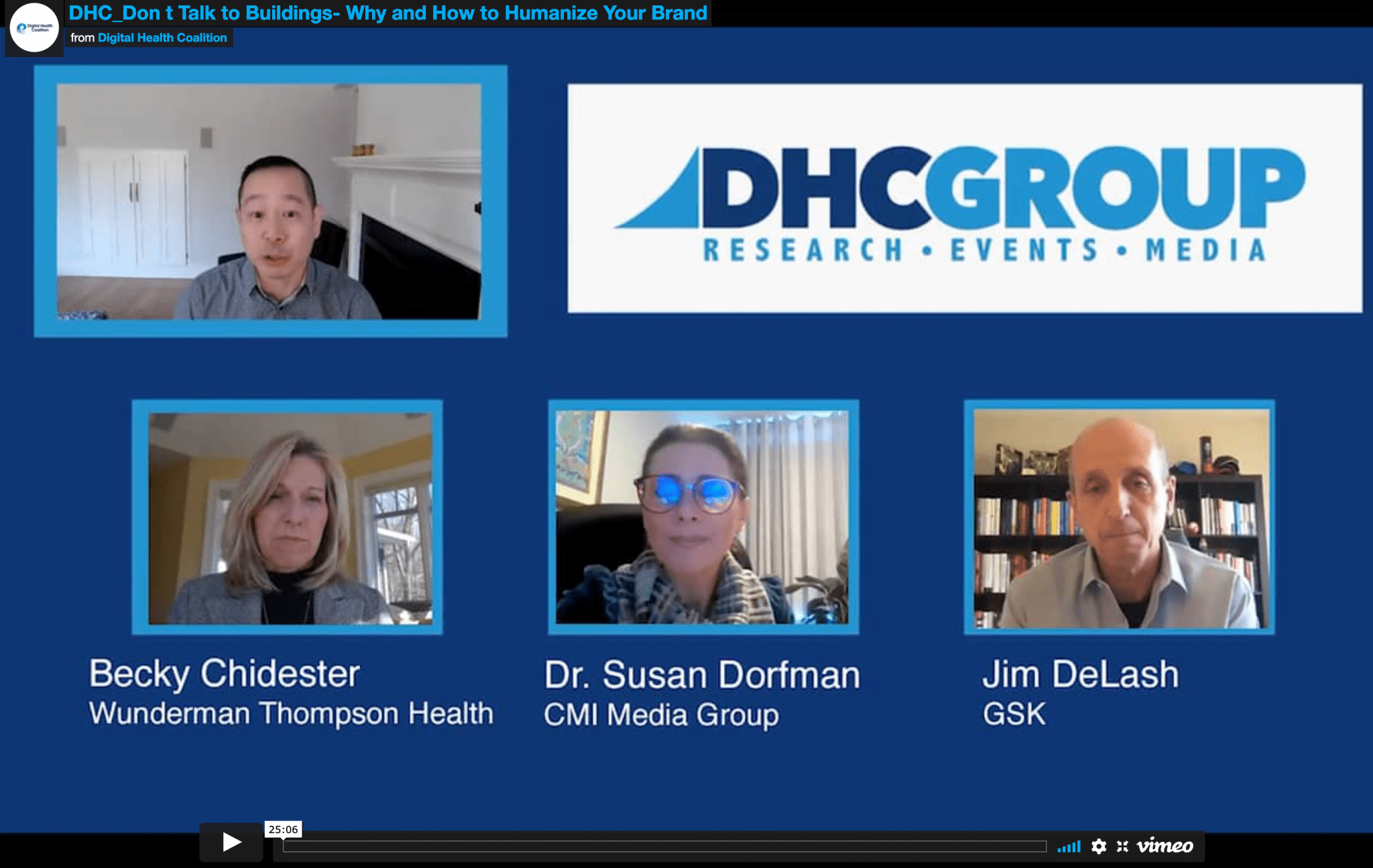Article
Why and How to Humanize Brands
April 2021

HCP Engagement Trends
In recent months, our industry has seen a sharp increase of interest in personalization technologies, but it’s easy to go down the wrong road. Brands need a solid strategy around customer engagement. As the customer demands more control over their choices, greater levels of interaction, and better experience, the focus on personalization of the customer experience needs to be balanced with the humanization of that experience.
At next week’s DHC Virtual Summit, speakers will focus on HCP engagement trends as well as the future of the customer experience. This summary of a recent DHC Summit panel on Why and How to Humanize Your Brand, moderated by CMI Media Group’s COO Eugene Lee, is an ideal read before-hand. Along with a look at how each panelist defined the unifying concept of the “human-centric approach” these experts provided key insights on how to focus efforts toward the right goal, with applications specific to HCP marketers.
Defining a “Human-Centric Approach” to Customer Experience and Engagement

Becky Chidester
CEO
Wunderman Thompson Health
“What we’re talking about is pivoting and getting the industry to focus much more on the needs of people as opposed to just how will you engage them. Right now it is incredibly important to think about that because when you think about the needs of these audiences, whether they’re doctors or patients, we continue to hear that people are so bombarded with information.
Whether it is email or a digital platform or social, we’re spending a lot of time trying to get attention from people. COVID has clearly accelerated this migration to these digital platforms but we’re not spending enough time to really thinking about what customers really need and how to create experiences and an engagement that will drive the right level of behavior. Human-centric marketing is clearly putting the needs of the audience first and foremost and not the channels and capabilities.”

Jim Delash
Multi-Channel Marketing Director
GSK
“We need to look at the human part of marketing as literally ‘these are people that are receiving our messages’. With analytics showing the norms of response as 10% for a given channel, I’ve been thinking alot about the other 90%. What about the non-responders in whatever medium you’re looking or whatever message you have? The 90% who aren’t buying, there are multiple reasons.
The more you start to break that down, you end up with these microsegments, which gets you closer to this human part where there’s not one segment of 10,000 people. There may be 10 segments of 1,000 people that are unique in their own way and whose needs we can meet through digital and other channels.
Then the metrics come into play. We can ask if their needs are being met through the engagement metrics, and ultimately, their buying behaviors. If you only look at benchmarks and overall averages, you are missing that dimension of the human part of this connection that we all strive for.”

DR. Susan Dorfman
President
CMI Media Group
“There are two elements that I see that we need to talk about. One, everyone is talking about, and that’s personalization. Personalization is relevance, and in some ways, it’s transactional. “Treat people like who they are.” It’s a necessity. Taking that one step further from a humanization perspective.
Humanization brings an emotional connection to that. It goes from treat people like who they are to treat people like who they are matters. If we treat people like they matter, that is the humanization factor of it. That is the most important factor. That’s the connection that keeps.”
How to Treat Customers Like They, and Their Experience, Matters
Respect the Inbox
As Jim Delash says, or in other words, respect their attention. Pure data analytics may give you the impression that a big volume of emails/messages is successful. Even if that works out financially, any end-user would agree it’s not a great experience, especially if the content isn’t relevant to all of the recipients. Marketers should work to do something more than a “one size fits all” approach to content delivery. Treat people like they, and their time, matters.
Beware of the Health Inertia
A secondary impact of not respecting the inbox is that marketers risk bombarding customers with content and messages causing what Becky Chidester calls “health inertia”. In this scenario, customers may feel very informed based on the volume of brand/health-related content they have received, but there’s no resulting behavior change.
In the case of HCPs, doctors are sent a lot of information about the value around scientific innovation. But without a personal, humanizing component, it’s often just more content that they have absorbed but not acted on.
Make a Connection
To avoid health inertia, Dr. Dorfman recommends a data approach that goes beyond the standard demographics. Building a better understanding of personal motivations and identifying areas of possible emotional connection are key to bridging a focus on performance and outcomes with a humanizing approach. The former will ultimately have a better impact if we can connect with customers in personal ways and drive the right behaviors.
Applying the Human-Centric Approach to an HCP Engagement Strategy
Evaluate Your Operational Readiness Factors
Before you embark on this process that will require you to be agile and learn as you go, what are the things you need to already have in place? That speed and agility requires organizational readiness, so it is key to have the medical, regulatory, legal teams etc. brought into the conversation early. Involve other stakeholders and share the vision of a “humanized approach”.
A mindset of possible thinking and all players striving for that same goal is key. In an environment where the easiest answer might be “no” to a new idea, encourage a “let’s consider the benefit to the audience we’re talking to and the experience we’re creating” brainstorming mindset. Next, achieve organizational commitment with clearly defined budget, authority, and accountability.
Create the Best Experience Possible
Focus on creating the best experience possible for the identified HCP customer group, as well as identifying what you think you know about them. Jim Delash recommends “start with the aspiration of what you want your customers to see and feel”. Map that experience beyond just one tactic (email for example), include speaker programs, include the field force… include everything that’s relevant to make that experience the best possible for your business goal is.
Becky Chidester warns against being overwhelmed by a false impression that this will mean “creating thousands of assets. There are really efficient ways to still connect with people personally and have variable content” often by better utilizing your existing technology platforms.
When Evaluating Success, Define What to Measure
When evaluating the success of the effort, don’t look at it as a ‘tactic’. As you set goals and plan to measure them, take the time to define what you really want to measure. Is it return on opportunity, return on value? Return on promotional investment might not be the right metric. Employing a humanized approach is “mission-driven commitment” defines Susan Dorfman.
“It’s not just what you are saying but also what you are doing in support of the HCP, which is much more than the message.” Look for increased response rates and desired behaviors that can be attributed to better connecting with people more.
About the Author

Christine Franklin
Newsletter
Additional Resources

DHC May Virtual Summit
Want to hear more on HCP Engagement and the Customer Experience? Access resources from the recent DHC Virtual Summit hosted with AbbVie.

Why and How to Humanize Your Brand Video
Want to see the on-demand recording of the March DHC Summit Why and How to Humanize Your Brand?

Reaching HCPs in a Post-COVID World
Moving forward, how can you optimize your HCP communication strategy for future success? Let’s look at three key areas.
